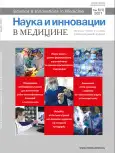Assessment of the necessary conditions for robot-assisted surgery in the nasal cavity
- Authors: Mareev O.V.1, Mareev G.O.1, Tsymbal D.D.1, Afonina O.I.1
-
Affiliations:
- Saratov State Medical University named after V.I. Razumovsky
- Issue: Vol 6, No 1 (2021)
- Pages: 14-19
- Section: ENT Disorders
- URL: https://bakhtiniada.ru/2500-1388/article/view/59046
- DOI: https://doi.org/10.35693/2500-1388-2021-6-1-14-19
- ID: 59046
Cite item
Full Text
Abstract
Objectives - to determine the necessary conditions for performing robot-assisted operations in the nasal cavity.
Material and methods. We have investigated the movement of an endoscope in space by measurements based on high-resolution computed tomography (CT) data. A total of 50 CT scans of the paranasal sinuses were used for this purpose. The tomograms were randomly selected from among the patients of the ENT clinic of the Saratov State Medical University. The main parameters characterizing the movement of the endoscope in the nasal cavity under the conditions set by us are the magnitude of its linear displacement from the entry point and the angle of its deviation, measured in three planes - frontal, sagittal and horizontal, provided that the planes of these sections pass through the entry point during various operations. To control these measurements, we detected the displacements of the endoscope in space using an optical tracking system we made, as well as specialized software designed specifically for the purpose of optical tracking. With the help of this device, measurements were carried out on the skulls and their models, the silicone model for endoscopic examination K. Storz 723128, as well as during real endoscopic operations on the paranasal sinuses. All studies were combined into groups according to the standard protocols of endoscopic operations performed endonasally: “Anterior ethmoidotomy”, “Posterior ethmoidotomy”, “Frontotomy”, “Sinusotomy”, “Sphenotomy”, “Adenotomy”.
Results. The main characteristics of the movement of the endoscope in the nasal cavity at a given entry point in the nostril area were established - its maximum linear and angular displacement during various types of FESS interventions for adults.
The results obtained by us can serve as the main criteria for the development of a specialized robot assistant that holds and moves the endoscope in space during FESS.
Keywords
Full Text
##article.viewOnOriginalSite##About the authors
Oleg V. Mareev
Saratov State Medical University named after V.I. Razumovsky
Email: ovmareew@mail.ru
ORCID iD: 0000-0002-7240-5651
PhD, Professor, the Head of the Department of otorhinolaryngology
Russian Federation, SaratovGleb O. Mareev
Saratov State Medical University named after V.I. Razumovsky
Email: dr-mareev@mail.ru
ORCID iD: 0000-0002-5906-8080
PhD, Professor, Department of otorhinolaryngology
Russian Federation, SaratovDenis D. Tsymbal
Saratov State Medical University named after V.I. Razumovsky
Author for correspondence.
Email: denonlp@yandex.ru
ORCID iD: 0000-0001-7483-3150
Postgraduate of the Department of otorhinolaryngology
Russian Federation, SaratovOlga I. Afonina
Saratov State Medical University named after V.I. Razumovsky
Email: novosti999@rambler.ru
ORCID iD: 0000-0002-5118-1812
PhD, Associate professor, Department of otorhinolaryngology
Russian Federation, SaratovReferences
- Hirschmann A. Endoscopy of the nose and its accessory sinuses. The Laryngoscope. 1903;13(10):810. doi: 10.1288/00005537-190310000-00015
- Tajudeen BA, Kennedy DW. Thirty years of endoscopic sinus surgery: What have we learned? World Journal of Otorhinolaryngology - Head and Neck Surgery. 2017;3(2):115-121. doi: 10.1016/j.wjorl.2016.12.001
- Messerklinger W. Endoscopy of the nose. Baltimore: Urban & Schwarzenberg, 1978.
- Stammberger H. Functional Endoscopic Sinus Surgery: The Messerklinger Technique Decker, 1991.
- Kane KJ. The early history and development of endoscopic sinonasal surgery in Australia: 1985–2005. Australian Journal of Otolaryngology. 2018;1(1):7. doi: 10.21037/ajo.2018.01.08
- Castelnuovo P, Dallan I, Battaglia P, et al. Endoscopic endonasal skull base surgery: past, present and future. Eur Arch Otorhinolaryngol. 2010;267:649-663. doi: 10.1007/s00405-009-1196-0
- Briner HR, Simmen D, Jones N. Endoscopic sinus surgery: advantages of the bimanual technique. Am J Rhinol. 2005;19:269-273. doi: 10.1177/194589240501900310
- Manickavasagam J, Segaram S, Harkness P. Functional endoscopic sinus surgery chopstick technique. Laryngoscope. 2010;120(5):975-7. doi: 10.1002/lary.20862 PMID: 20422694
- Raman R, Prepageran N. Novel use of a Leyla-Yasargil retractor as an endoscope holder during endoscopic sinus surgery. Ear Nose Throat J. 2004;83(4):270. doi: 10.1177/014556130408300416, PMID: 15147098
- Hanna EY, Holsinger C, DeMonte F, et al. Robotic endoscopic surgery of the skull base: a novel surgical approach. Arch Otolaryngol Head Neck Surg. 2007;133:1209-1214. doi: 10.1001/archotol.133.12.1209
- Dallan I, Castelnuovo P, Seccia V, Battaglia P, et al. Combined transnasal transcervical robotic dissection of posterior skull base: feasibility in a cadaveric model. Rhinology. 2012;50(2):165-470. doi: 10.4193/rhin11.117
- Trévillot V, Garrel R, Dombre E, et al. Robotic endoscopic sinus and skull base surgery: review of the literature and future prospects. Eur Ann Otorhinolaryngol Head Neck Dis. 2013;130(4):201-7. doi: 10.1016/j.anorl.2012.03.010. Epub 2013 May 28. PMID: 23725665
- Kristin J, Geiger R, Kraus P, Klenzner T. Assessment of the endoscopic range of motion for head and neck surgery using the SOLOASSIST endoscope holder. Int J Med Robot. 2015;11(4):418-23. doi: 10.1002/rcs.1643. Epub 2015 Feb 1. PMID: 25640259
- Nathan CO, Chakradeo V, Malhotra K, D'Agostino H, Patwardhan R. The voice-controlled robotic assist scope holder AESOP for the endoscopic approach to the sella. Skull Base. 2006;16(3):123-131. doi: 10.1055/s-2006-939679
- Mareev GO, Mareev OV. Problems of creating systems of surgical robotics (part 1). Mir nauki, kul'tury, obrazovaniya. 2014;5:218-222. (In Russ.). [Мареев Г.О., Мареев О.В. Проблемы создания систем хирургической робототехники (часть 1). Мир науки, культуры, образования. 2014;5:218-222].
Supplementary files










